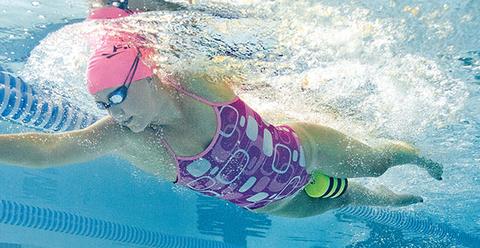Freestyle swimming body positioning for speed
By Phil Gerrard, Updated 20th of March 2021

Looking to improve your freestyle swimming speed? Some of the biggest improvements will come not with training and muscular strength, but technique improvements. Body positioning in the water is vitally important. In this article I focus on understanding the importance of a horizontal body position, and give tips on how this can be achieved.
So what is a horizontal body position? It’s keeping your whole body in a low resistance horizontal position as you swim. The flatter your body position in the water, the less resistance you encounter.
Simplifying freestyle body position
Once you start swimming freestyle, there are so many aspects of your stroke that will interfere with your best intentions regarding body positioning… You need to kick, you need to stroke, you need to deal with body rotation. You need to breathe! All of these actions have the potential to put you in a sub-optimal body position.
To work on your body positioning, you need to simplify the situation. And I mean really simplify it! We start by getting rid of any other distraction, and try to float horizontally in the water (with your face submerged, looking at the bottom of the pool). Don’t try and go anywhere. Don’t stroke. Just try and float with your arms by your side. It’s not a workout! But remember, swimming is as much about technique as strength and aerobic endurance.
So how did that go? Could you float horizontally? Were your feet and hips up at the water’s surface? If not, you have some work to do. Perseverance is important here. If you can’t make this work without stroking, it’s not going to happen when you are swimming.
There are a lot of adjustments you can make to change your body position. You may be pulling your legs down. If you hold your head high, your feet will drop. If you are nervous in the water, you may be shallow breathing.
Working with a pull buoy
So what can you do?
Firstly, grab a pull buoy and pop it between your upper legs. Float face down, arms by your side. All we are doing here is learning what correct positioning feels like. You need to be able to feel the ideal position if you have any chance of incorporating an improved body position in your stroke.
With the pull buoy, your legs should be floating at the surface. Play around with head position, and see how this changes the height of your legs in the water. Try lifting your forehead. Try looking straight at the bottom of the pool. Many people swim freestyle with their face forward in an attempt to breathe easily. This is a no-no. With this exercise, you can see that as soon as you raise your forehead, you force your legs down. In a way, this exercise not only demonstrates good body positioning, it also may demonstrate other aspects of your stroke that may need improvement.
Now, let’s move on to upper body positioning. This is complex and best practiced at home before trying in the pool. Find a vertical wall, and stand with your heels, head, and back against the wall. Try and flatten the bottom of your spine by pulling your belly button in with your core muscles. Then tuck in your chin in, straightening your neck. Make sure you are looking straight ahead, and not at the ground. Last step is to push your chest forward. As you do this, don’t change your lower spine and head positions. Your chest may come off the wall – that’s fine. Observe this position. Learn what it feels like.
With that position learnt, at the pool go and recreate the position while in the water with your pull buoy. Take a deep breath. Pull in the belly button, flattening your lower spine. Tuck in your chin. Then push out your chest. Now, when you push out your chest, you are pushing it to the bottom of the pool rather than forwards. All going well, you will notice that pushing your chest will raise your legs in the water.
What a lot of swimmers find at this point is while their legs are positioned higher, they feel their upper body and head are too submerged in the water for freestyle. They are not. The swimmer not only needs to improve their body position, they need to learn to effectively rotate their body during the freestyle stroke to allow breathing and the recovery arm sufficient height above the water.
Moving on from your horizontal floating position
Once you can float in a good position (with a pull buoy, and possibly without), you are left with the challenge of incorporating the rest of your stroke whilst maintaining this ideal body position. Quite a challenge really! Use your pull buoy, and try and go a few strokes after pushing off the wall - without any kicking or breathing. Removing the kick and breathing drastically simplifies the task. If your stroke pulls your body out of position, you may need to work on body rotation. Incorporate swimming with a pull buoy for several laps into your routine. These laps aren’t about a physical workout. They are to improve your technique by feeling a stroke that allows you to maintain correct body positioning.